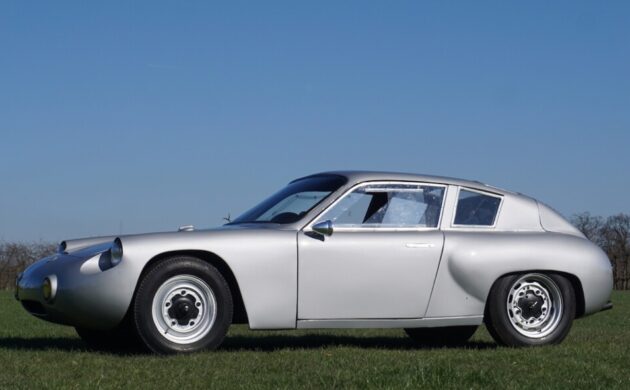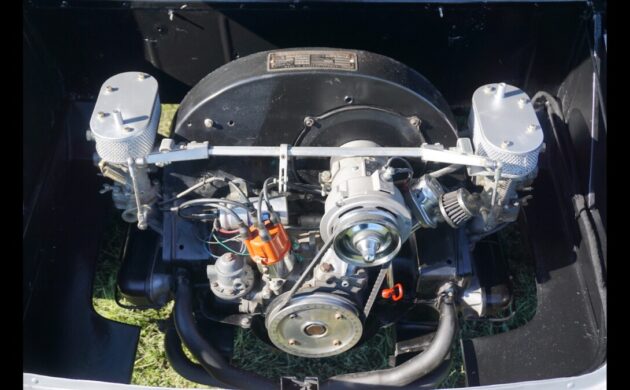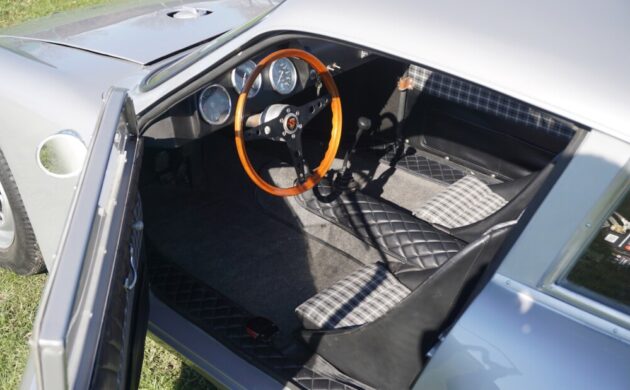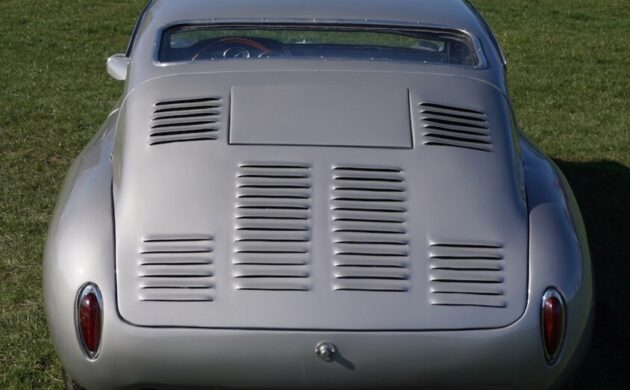Nevadahalftrack sent us a tip that was no doubt meant to confound the Barn Finds research capabilities. Here at Car & Classic is a 1953 Porsche 356 Abarth Borghi with an asking price of €195,000, located in Belgium, and yes, this is a car with a story. To understand this car, we must for a moment set aside thoughts of Abarth, who started his company in Bologna, Italy in 1949. Instead, we introduce a new character: Aldo Borghi founded Carroceria Borghi sometime before 1950 in San Fernando, Argentina. Borghi specialized in aluminum bodywork, one-offs, and race car reconstruction, as he was known to have re-bodied retired or crashed cars. Our subject car began life as a model-year 1954 Porsche 356. In 1963, after accumulating fire damage, the car’s remains were delivered to Borghi. Inspired by the Porsche Abarth Carrera cars running on tracks around the world, Borghi designed a similar body while keeping the lines distinct from the European car. Finished in 1965, the car changed hands in 1972 and was subsequently raced and rallied. After 1990, a new owner restored the car to its “Borghi-build” specifications. Before we leave this photo, note the wavering fit of the driver’s door along its lower edge.
The car’s rear-mounted motor is a 1600 cc Super 90 built to produce 110 hp, up from the car’s stock output of 90 hp. The seller notes a 130 mph top speed and a zero to sixty time of about 9 seconds. “Abarth specs” is noted on the description of the powerplant, but no explanation of that note is supplied. Apparently, the original engine was a 1500 cc type 546. The gearbox is a four-speed manual.
The interior is equipped with gauges stenciled with the Porsche crest set in aluminum bezels, a set of rally timers, plaid upholstery over Zagato-type seat frames, and quilted fabric covering the sills and transmission tunnel. This photo shows the gas tank filler in the hood. Hard to tell if that hood is perhaps open, but it does sit proud of the body.
The car’s rear is thoroughly louvered to aid cooling, but the workmanship looks just a tad drunk. Speaking of bodywork, let’s revert to Mr Abarth. It’s worth noting that neither Abarth nor the oft-thought-of Zagato built the Porsche Abarth Carrera. Abarth didn’t even design the car; that honor belonged to Scaglietti. The first car was built by Viarenzo & Filliponi; after that, Rocco Motto’s Turin shop – “forty-five men and three power hammers” – managed to wrangle the job for a production run of several cars. So it was really Scaglietti’s design and Motto’s coachbuilding that Borghi was copying, leaving me to wonder – what of Abarth is in this car?






There were, and still are, several ’50s Porsche renditions by European specialty shops scattered around the world. Was the thing to do in those days. Most hand made, either by large custom builders or small shops turning out a car a year. Porsche wasn’t the only target as Fiat, Alpha Romeo, and even some British cars like the Austin Healeys joined the crowd. There is a book out there somewhere that chronicles these kinds of automotive art from the early 1900s to the present day.
Yes, I learned that IAME made the Justicialista based on a Porsche and later, Teram received approval to badge cars with “Porsche” – a whole hot-bed of collecting I never knew about.
What Abarth contributed to the 356 Abarth Carrera was that it couldn’t exist without him.
Like the Porsche family, Karl Abarth was a displaced Austrian. He worked closely with Porsche on the Cistitalia F1 project which bankrupted its founder, Piero Dusio. Abarth picked up the pieces and the first cars to wear his badge were warmed over Cisitalia chassis.
When Porsche needed a lighter version of the 356 to keep the company competitive in GT Endurance racing, the company realised that their ex-colleague had written the game plan with his little Fiat-based GTs and could fix it for them.
Porsche was running in a different class to Abarth, so getting involved had no negative impact on his competitive posiyion but was good for cashflow. And Porsche got tje results they needed, more or less.
As to this car, beware of Belgians selling Italian racers with sketchy pasts. On the other hand, Argentina hosts some brilliant craftsmen, this car looks great and people pay more money than this for a perfect version of a lesser car in the 356 market.
There is also the holy grail on Porsche history; Porsche, Excellence Was Expected by Karl Ludvigsen. Over 850 pages of history.
“ Nevadahalftrack sent us a tip that was no doubt meant to confound the Barn Finds research capabilities.”
You give me too much credit, Michelle. Your stellar investigative skills plus the library of knowledge on BF (bobhess and Bob McCloskey come immediately to mind) about unusual sports cars-or ANYTHING we’ve seen thrown out there-will find the automotive cup of the Holy Grail every time.
This example was so different from the genuine Porsche Abarth that I saw many years ago in a private garage in a city near here that I had to send it in.
Thank you for proving me right!😁
No way to put a modern day legit auction value on such a build. You mention “drunk” and I’m sure several bottles of vino were consumed in this re-build. It does look German, I’ll say that but not sure a Concourse Event such as Pebble Beach would accept such a Frankenstein build. 110hp is terrible… my brother’s 68 Super Beattle would probably beat it. All the great Italian Coach Builders were dead by then, this is a resurrection but not much else!
jv – smash palace
Looks to me like something drawn on the back of a napkin and built in somebody’s back yard. The funny thing is it probably looks better now after the restoration than it did when built. There’s nothing wrong with taking a wrecked car and turning it into something to race, but expecting this kind of money just because it started life as a Porsche seems kind of ridiculous. I wouldn’t pay a hundred grand to someone who turned an old Camaro into a dirt track car after all.
Powerplant looks a lot like my 71′ VW superbeetle. “Huh”…
Very pretty build.Would like to know racing/rallying history.
This is likely a modern knock off of the Porsche Abarth from the early 60s. The large hump of the central tunnel is typical of VW, not of Porsche. There is a Porsche engine at the back, but the original cars used the 4 cam engine rather than this pushrod motor.
I doubt this car has any racing/rally history.
A very interesting Porsche outlaw to be sure. One correction: Scaglione not Scaglietti designed the originals for Carlo Abarth.
Thanks for the correction!
Looks as if the Luftwaffe had first dibs on the wind tunnel when that brick was being designed.
Uh, nope! Too ugly
I have a very different point of view regarding this car.It is a genuine unique bodied real 356 special. It has many Abarth touches and I think it looks amazing.For a one off I’d expect some waving lines etc.But to me that adds to it. I’d love to have this and would drive the hell out of it ( just finished a Breakfast Club Rally yesterday in my 56A Outlaw). This would be an amazing step up from my lovely A IMHO.Wish I could afford it.
the rear louvers alone tell me of Italian involvement. Driving in Germany (more rain) would be tough? Oh, race car? No use for toys, this is a budget operation. I saw the Italian/French. Did not know of the Italian/German connection cept for Lancia assisting Porsche (man to man, not companies) w/recovery after nazi treatment. Thnx for da pic !
Tell us about Lancia assisting Porsche after WW2!
Think you hsve your facts twisted.
I ran an antique car restoration & sales shop just north of Washington DC, and was contacted by various Embassies looking to help their countrymen in finding old cars & spare parts.
I ended up befriending a man from one of the 2 southernmost S. American countries, and we arranged for importation of some cars he sourced in that region. Some comments:
1. At least in the 1980s and ’90s, What counted as a well-restored car in South America would be considered a hack job here in the USA.
2. In the 1980s I spoke with a couple of shops in Argentina willing to make any type of alloy body I wanted, for any car. The work being done by tiny 1 or 2 man shops where everything was done by hand.
3. We brought up a 1934 Buick series 60 phaeton that had been “fully restored to a high quality”. Turned out to be a series 40 sedan that lost it’s roof, and the tinkertoy roof mechanism was hand made but quickly failed. The center door posts were held together by a length of angle iron running across behind the front seat. It’s interior was also fully restored using the highest grade leather possible. This was true, except the leather used was un-treated, un-dyed SADDLE leather!
4. I agree with Chas H that on this Porsche the central chassis tunnel is VW, not Porsche 356. I would highly suggest that any possible buyer have this checked over by a qualified Porsche 356 expert, and research the build quality of Borghi cars. If Borghi cars typically featured cooling louvers that were uneven in height and length, and panel fit was poor like we see it on this car, then perhaps the restoration was accurate. But I have serious doubts, because the few Borghi cars [pre-ww2cars built in Italy prior to Borghi moving to Argentina] I’ve found appear to have beautiful workmanship. The cars can be found at Coachbuilt.com, under Borghi
This car was offered at auction in Belgium 2 months ago, but did not meet reserve: https://www.auctomobile.com/auctions/results/1953-63-porsche-356-borghi.html
A brief history is told, where they state that the original car was in a fire that made restoring the car impossible, but that “the mechanics and running gear were of interest” [to Borghi]. This suggest to me it does not have the original Porsche chassis pan.
If this is indeed a genuine later Borghi body on a Porsche 356 pan, and the build quality matches how it looked when finished in the early 1960s, then the price is not out of line.
In this case, provable history is everything.
Forgot to mention;
What appears to be a German [state government] VIN plate is not on the body, but attached to the top of the air cooling plenum on the engine. Having lived in Germany and knowing their laws governing placement of the VIN plate is restricted to the main body [if unit-body construction] or the frame, I question the placement of the VIN plate on the engine cowling! I wonder if the stamped VIN on the rear of the center pan tunnel, matches the VIN plate on the engine.
Clearly the car is built on a VW chassis. The wheels, non-vented in front which would never happen on a race car, are secured by bolts to iron drums. Porsche used studs in aluminum drums. The lack of air seals around the engine is another sign of amateur work, as the engine is free to draw in the hot air it just exhausted.
Nope, nope, nope.
The only aluminum drums Porsche had were the steel lined units on the ’60 through ’63 356B. There were aftermarket aluminum drums available toward the later ’50s but these don’t look like them.
All drum brakes on Porsche 356 cars were aluminum. Porsche started with disc brakes in the C series.
Lost part of my reply in an internet dump. Should have read: Aluminum drums with steel liner were introduced around early 1950 and replaced the VW drums on the early cars. They went to finned drums with steel liners for the ’60 through ’63 356 B. There were aftermarket aluminum drums available toward the later ’50s but these don’t look like them. Agree with ChasH that the interior looks VW. We did race our two 356 race cars without the pans around them because the engines were higher up due to raising the transmission up to get good rear wheel geometry. No problem on the track but wouldn’t work just driving around town.
This reminds me of a more recent but better Abarth Carrera funded and built by my friend and neighbor Al Lager in Lakewood, Colorado. He took a 356B chassis to an aluminum body builder in Loveland, Colorado with a good set of dimensions taken from a real car. They built an aluminum body that was about 90 percent true to the original, and if you didn’t know it, you’d have thought it was the real thing. Meanwhile he built a hot 356 engine with a four-cam-type shroud and fan, etc, all made to look like a real four-cam. The body was left unpainted, just polished. Al had a fortune in it, and after he passed it was sold.
Easy to check if its a VW underneath..just look. I agree that the tunnel looks VW ( just checked the one on my 56 with a flat top). If it is built on a real Porsche chassis I think the price is not over the top.If its a special bodied VW on a Beetle chassis…then maybe $50,000 or a little more not unlike the hand built cars coming from that young man in Minnesota.Still be a cool car to have but I’d be honest about its roots..
Interrestingly so many interresting (haha) cars emerge from Argentina. A fake all around. Not worth 50 quid. But its a sign of the time, show off and have something special. And special it is. At least in the bug department. I would say, someone found a picture from a long lost racing car, took a beetle pan and some funny parts, did some researching and here we go, 10 grand invested, some profit made. On the other hand I do not pitty the buyer, he will be allowed to all the major events, at least the expensive ones, as he is paying the entrance fee. Big smile!
regards from Tyrol
Wow, a face only a mother could love! The whole thing looks clumsy, out of proportion and is not reminiscent of the quality of a true coachbuilder. Just look at the bonnet for goodness sake! It looks like they just cut the side out of an old oil tank and laid it in place. Hmm, yep, that’ll do. It almost fits! Hard pass!
Agreed!
Let me put it this way..I’d rather have this than a phony Speedster or Spyder posing as a real Porsche.If it has a VW chassis ( something still not proven here yet) I’d tell folks it a one off VW Special..with a Porsche motor and inspired by Abarth..to me that still makes it unique and ,if it drives well and should be light, it might be a hoot through the Sonoma backroads I like so much.Big plug for folks to sign up for the Breakfast Club rallies held around here to see and run with some great, some oddball but exciting machinery..like this (much more fun than Cars and Coffee)
Malcolm, I agree this is more interesting than a fake speedster, etc.
What worries me is the possibility that this is being offered [for $200,000] as a 1954 Porsche with an updated engine, not as a VW with a Porsche engine, I feel it’s important to let possible buyers [or the current owner] know & confirm IF there is no stamped VW VIN on the back end of the center tunnel. If a VW number exists on that pan, that’s the actual VIN, not the Porsche VIN.
The German VIN plate appears to have been incorrectly affixed to a removeable fan shroud on the engine, not to the body/chassis/pan. If all the claimed historical racing info is based on that chassis VIN, then that info can be transfer to another vehicle simply by changing that one fan shroud.
I don’t see any Porsche factory logo or info etched into the VIN plate attached to the engine, and it appears to be a generic German VIN plate, required to be installed on any vehicle imported into Germany. My Tatra had to have one of these plates installed when it came into Germany from CZ. we had no problem getting one because blank plates are legal to purchase.
I agree with all you say and I would never consider buying a car like this without going thro it tooth and comb.Still, must say, I love the look and idea of it…but not for $200,000 if its VW Special…